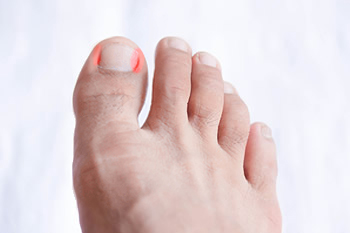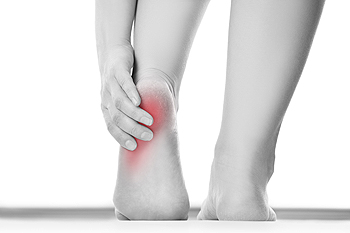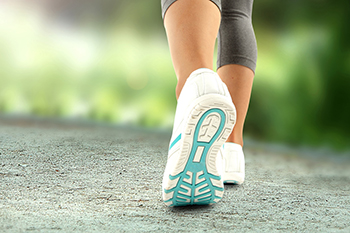Items filtered by date: August 2021
Footwear Tips for Walking
Walking is a great low-impact way to lose weight, strengthen muscles, improve circulation, and more. However, it is important to use footwear designed specifically for the biomechanics of walking. Walking is done with a steady heel-to-toe stride, transferring body weight evenly from the heel to the toe. This motion begins with the heel striking the ground first, followed by a rolling motion through the heel to the toes, and then a pushing out of the stride with the toes. A good walking shoe will support and facilitate this motion in a few ways. Walking shoes should be flexible at the forefoot to allow the foot to flex during the heel-to-toe walking stride. A walking shoe should provide adequate cushioning, but not as much in the forefoot as a running shoe. This makes walking shoes lighter in weight, which help keep you comfortable. Regarding the heel, straight (or undercut) heels are best for walking shoes—as opposed to wider, higher, or flared heels in running shoes which may interfere with the walking stride. Before embarking on any fitness walking regimen, consult with a podiatrist for additional footwear/foot health advice—particularly if you have an existing medical condition.
For more information about walking shoes versus running shoes, consult with Chiropodist Stephanie Poupore from North Bay Foot & Ankle. Our clinician can measure your feet to determine what your needs are and help you find an appropriate pair of footwear.
Foot Health: The Differences between Walking & Running Shoes
There are great ways to stay in shape: running and walking are two great exercises to a healthy lifestyle. It is important to know that running shoes and walking shoes are not interchangeable. There is a key difference on how the feet hit the ground when someone is running or walking. This is why one should be aware that a shoe is designed differently for each activity.
You may be asking yourself what the real differences are between walking and running shoes and the answers may shock you.
Differences
Walking doesn’t involve as much stress or impact on the feet as running does. However, this doesn’t mean that you should be any less prepared. When you’re walking, you land on your heels and have your foot roll forward. This rolling motion requires additional support to the feet.
Flexibility – Walking shoes are designed to have soft, flexible soles. This allows the walker to push off easily with each step.
If you have any questions, please feel free to contact our office located in North Bay, ON . We offer the newest diagnostic and treatment technologies for all your foot care needs.
Keep Your Feet Healthy So You Can Stay Active
Are You Experiencing Bunion Pain?
 A bunion is a bony bump that can form at the base of the big toe joint. Many people believe that bunions are a strictly cosmetic issue, only affecting the way that the foot looks, but bunions can also be painful and lead to other foot problems that may interfere with your day-to-day life. A bunion can push your big toe towards the smaller ones, changing the shape of the foot and making the big toe joint sore, stiff, swollen, or inflamed. Blisters, corns, and calluses may form in between or on top of the toes as your shoe rubs against the bunion. All of these symptoms can lead to difficulty walking and going about your daily activities. Furthermore, bunions can increase your risk of other potentially painful foot problems, including hammertoes, bursitis, and metatarsalgia. Bunions tend to worsen over time, so if you notice a bunion forming on your foot, it is suggested that you see a chiropodist for treatment as soon as possible.
A bunion is a bony bump that can form at the base of the big toe joint. Many people believe that bunions are a strictly cosmetic issue, only affecting the way that the foot looks, but bunions can also be painful and lead to other foot problems that may interfere with your day-to-day life. A bunion can push your big toe towards the smaller ones, changing the shape of the foot and making the big toe joint sore, stiff, swollen, or inflamed. Blisters, corns, and calluses may form in between or on top of the toes as your shoe rubs against the bunion. All of these symptoms can lead to difficulty walking and going about your daily activities. Furthermore, bunions can increase your risk of other potentially painful foot problems, including hammertoes, bursitis, and metatarsalgia. Bunions tend to worsen over time, so if you notice a bunion forming on your foot, it is suggested that you see a chiropodist for treatment as soon as possible.
If you are suffering from bunion pain, contact the specialists of North Bay Foot & Ankle Clinic. Our chiropodist can provide the care you need to keep you pain-free and on your feet.
What Is a Bunion?
Bunions are painful bony bumps that usually develop on the inside of the foot at the joint of the big toe. As the deformity increases over time, it may become painful to walk and wear shoes. Women are more likely to exacerbate existing bunions since they often wear tight, narrow shoes that shift their toes together. Bunion pain can be relieved by wearing wider shoes with enough room for the toes.
Causes
- Genetics – some people inherit feet that are more prone to bunion development
- Inflammatory Conditions - rheumatoid arthritis and polio may cause bunion development
Symptoms
- Redness and inflammation
- Pain and tenderness
- Callus or corns on the bump
- Restricted motion in the big toe
To diagnose your bunion, your chiropodist may ask about your medical history, symptoms, and general health. Your chiropodist might also order an x-ray to take a closer look at your feet. Nonsurgical treatment options include orthotics, padding, icing, changes in footwear, and medication. If nonsurgical treatments don’t alleviate your bunion pain, surgery may be necessary.
If you have any questions, please feel free to contact our office located in North Bay, ON. We offer the newest diagnostic and treatment technologies for all your foot care needs.
How to Avoid Ingrown Toenails
 Ingrown toenails can be painful, embarrassing, and—at worst—may even become infected, swollen, red, or purulent. You can put yourself more at risk of getting an ingrown toenail if you trim your nails improperly or too short. Your toenails should be cut straight across, but not so short that they grow into the surrounding skin. Ill-fitting shoes, tight socks, and sweaty feet can compromise the skin around your toes and make it easier for your nail to pierce or press into the skin and eventually grow into it. Even stubbing your toe or other injuries can make it more likely for an ingrown toenail to develop. If your ingrown toenail progresses, a chiropodist has a variety of treatments to relieve pain and pressure and to prevent infection.
Ingrown toenails can be painful, embarrassing, and—at worst—may even become infected, swollen, red, or purulent. You can put yourself more at risk of getting an ingrown toenail if you trim your nails improperly or too short. Your toenails should be cut straight across, but not so short that they grow into the surrounding skin. Ill-fitting shoes, tight socks, and sweaty feet can compromise the skin around your toes and make it easier for your nail to pierce or press into the skin and eventually grow into it. Even stubbing your toe or other injuries can make it more likely for an ingrown toenail to develop. If your ingrown toenail progresses, a chiropodist has a variety of treatments to relieve pain and pressure and to prevent infection.
Ingrown toenails can become painful if they are not treated properly. For more information about ingrown toenails, contact the specialists of North Bay Foot & Ankle Clinic. Our chiropodist can provide the care you need to keep you pain-free and on your feet.
Ingrown Toenails
Ingrown toenails occur when a toenail grows sideways into the bed of the nail, causing pain, swelling, and possibly infection.
Causes
- Bacterial infections
- Improper nail cutting such as cutting it too short or not straight across
- Trauma to the toe, such as stubbing, which causes the nail to grow back irregularly
- Ill-fitting shoes that bunch the toes too close together
- Genetic predisposition
Prevention
Because ingrown toenails are not something found outside of shoe-wearing cultures, going barefoot as often as possible will decrease the likeliness of developing ingrown toenails. Wearing proper-fitting shoes and using proper cutting techniques will also help decrease your risk of developing ingrown toenails.
Treatment
Ingrown toenails are a very treatable foot condition. In minor cases, soaking the affected area in salt or antibacterial soaps will not only help with the ingrown nail itself but also help prevent any infections from occurring. In more severe cases, surgery is an option. In either case, speaking to your chiropodist about this condition will help you get a better understanding of specific treatment options that are right for you.
If you have any questions, please feel free to contact our office located in North Bay, ON. We offer the newest diagnostic and treatment technologies for all your foot and ankle needs.
The Many Causes of Heel Pain
 Heel pain can have a variety of causes, but the most common cause of it is plantar fasciitis. This occurs when the long band of tissue on the sole of the foot becomes inflamed. Women late in their pregnancy and people who waitress or work on their feet all day may be more at risk for developing this type of heel pain. Other causes of heel pain can include: a small crack in the heel bone, compressed nerves, worn down heel pads, nerve damage, thickened tissue surrounding a nerve, inflammation of the tendon that connects the heel bone with the calf muscles, plantar warts, and abnormalities in the bone which can causes inflammation of the bursa sac. There may also be injury to the tunnel between the heel and talus bones known as Sinus Tarsi Syndrome. If you are struggling with any type of pain in your heel it is suggested that you schedule an appointment with a chiropodist for an accurate diagnosis and proper treatment.
Heel pain can have a variety of causes, but the most common cause of it is plantar fasciitis. This occurs when the long band of tissue on the sole of the foot becomes inflamed. Women late in their pregnancy and people who waitress or work on their feet all day may be more at risk for developing this type of heel pain. Other causes of heel pain can include: a small crack in the heel bone, compressed nerves, worn down heel pads, nerve damage, thickened tissue surrounding a nerve, inflammation of the tendon that connects the heel bone with the calf muscles, plantar warts, and abnormalities in the bone which can causes inflammation of the bursa sac. There may also be injury to the tunnel between the heel and talus bones known as Sinus Tarsi Syndrome. If you are struggling with any type of pain in your heel it is suggested that you schedule an appointment with a chiropodist for an accurate diagnosis and proper treatment.
Many people suffer from bouts of heel pain. For more information, contact the specialists of North Bay Foot & Ankle Clinic. Our chiropodist can provide the care you need to keep you pain-free and on your feet.
Causes of Heel Pain
Heel pain is often associated with plantar fasciitis. The plantar fascia is a band of tissues that extends along the bottom of the foot. A rip or tear in this ligament can cause inflammation of the tissue.
Achilles tendonitis is another cause of heel pain. Inflammation of the Achilles tendon will cause pain from fractures and muscle tearing. Lack of flexibility is also another symptom.
Heel spurs are another cause of pain. When the tissues of the plantar fascia undergo a great deal of stress, it can lead to ligament separation from the heel bone, causing heel spurs.
Why Might Heel Pain Occur?
- Wearing ill-fitting shoes
- Wearing non-supportive shoes
- Weight change
- Excessive running
Treatments
Heel pain should be treated as soon as possible for immediate results. Keeping your feet in a stress-free environment will help. If you suffer from Achilles tendonitis or plantar fasciitis, applying ice will reduce the swelling. Stretching before an exercise like running will help the muscles. Using all these tips will help make heel pain a condition of the past.
If you have any questions, please contact our office located in North Bay, ON. We offer the newest diagnostic and treatment technologies for all your foot and ankle needs.


